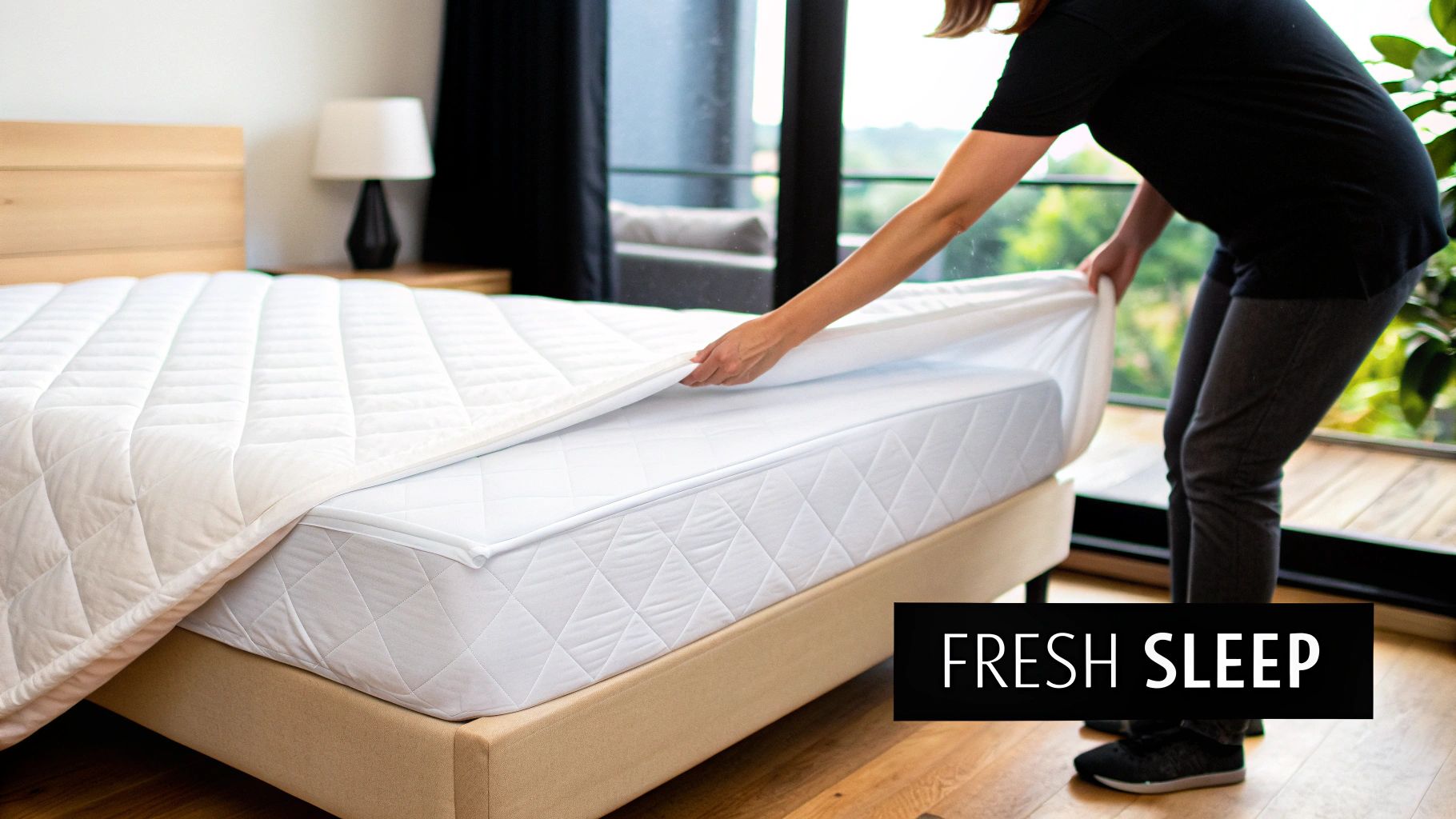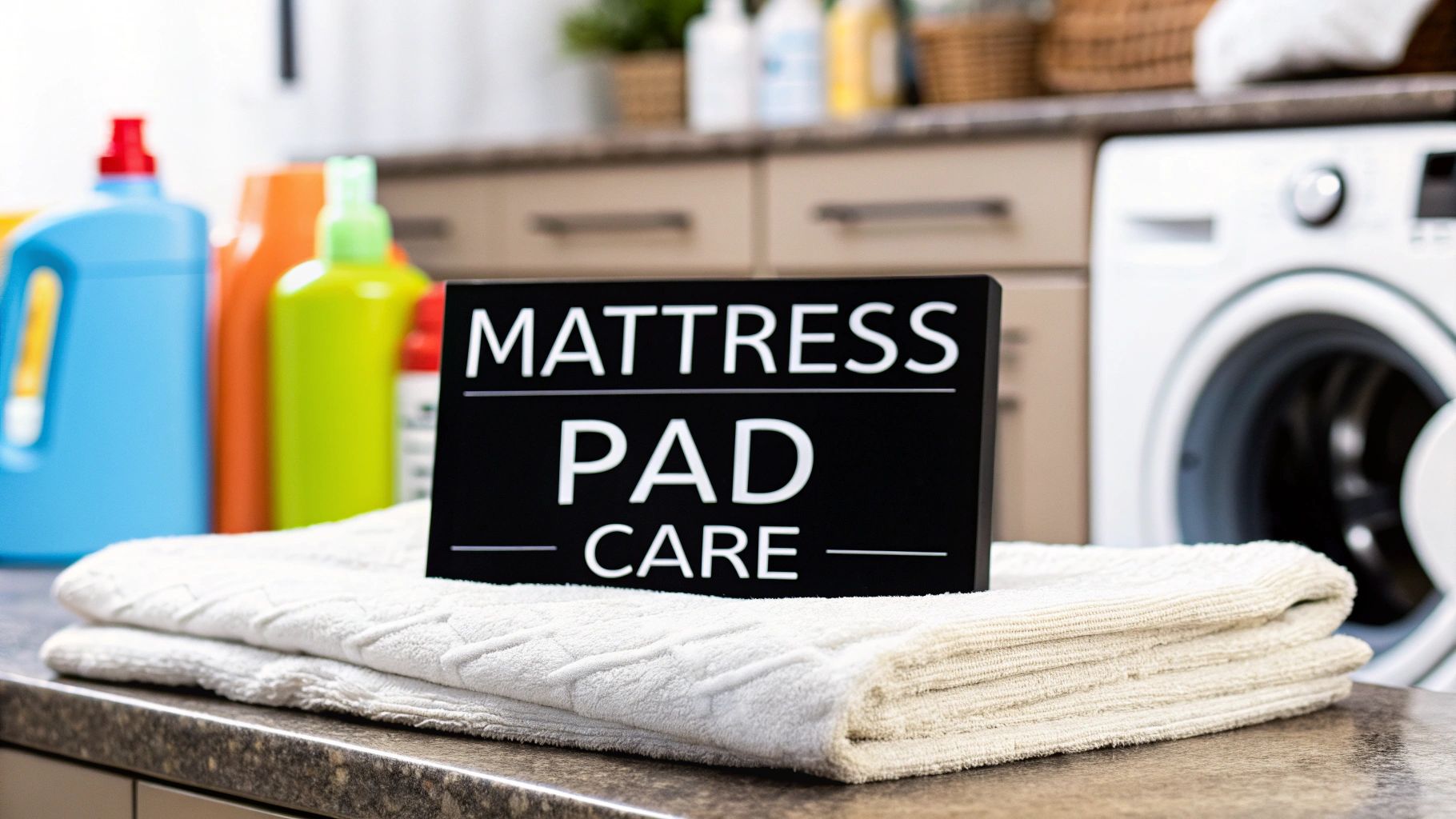Knowing how to properly clean a mattress pad is key to creating a truly comfortable and hygienic place to sleep. For most pads, a gentle cycle with a mild detergent and a low heat tumble dry will do the trick, but always check the care label first. It’s the golden rule for keeping your bedding in top condition.
This simple step is the foundation of a healthier, fresher bed.
Why Cleaning Your Mattress Pad Matters

Think of your mattress pad as the unsung hero of your bedroom. Night after night, it provides a soft, protective barrier between you and your mattress. Over time, this hardworking layer absorbs sweat and body oils, and can become a haven for dust mites and other allergens.
Washing your mattress pad regularly isn’t just another household chore. It’s an essential part of good sleep hygiene and crucial for ensuring you get properly restorative rest. If you're keen to create the perfect sleep setup, it's worth understanding what good sleep hygiene is and the profound impact it has on your overall wellbeing.
The Benefits of a Freshly Cleaned Pad
Putting in a little effort to keep your mattress pad clean pays off in a big way, with benefits you'll feel every time you climb into bed.
- Extends Mattress Life: Your mattress was a significant purchase. A clean pad is its first line of defence, shielding it from spills and moisture that can break down the materials over time.
- Reduces Allergens: Bedding can be a prime spot for dust mites, a major trigger for allergies. Regular washing gets rid of these microscopic pests, along with trapped pollen and pet dander, which can help you breathe more easily through the night.
- Unbeatable Comfort: There's simply no substitute for the feeling of slipping into a genuinely fresh, clean bed. It creates a sense of calm that helps you unwind and sets the stage for a wonderful night's sleep.
A clean mattress pad is the foundation of a hygienic bed. It not only protects your mattress but also ensures you are resting in a fresh, allergen free space every night.
Your Pre Wash Checklist for a Perfect Clean
A little prep work before you start washing is the secret to getting your mattress pad perfectly clean without any drama. Taking just a few moments to get organised will help you avoid common mistakes, like using water that’s too hot or a detergent that’s too harsh, which can easily damage the delicate fibres.
First things first, find the care label on your mattress pad. Those little symbols are your roadmap, telling you exactly what temperature and wash cycle your pad can handle. Honestly, getting this right is the most important part of the whole process.
Gather Your Cleaning Supplies
Once you've decoded the care label, it's time to gather your tools. Having everything ready to go makes the job feel so much easier.
Here's what you'll want to have on hand:
- A Gentle Detergent: Always opt for a mild, non biological detergent. These are much kinder to fabrics and a better choice for anyone with sensitive skin.
- A Good Stain Remover: For any obvious spots or spills, a targeted stain remover is a must. A commercial product works well, but a simple paste made from baking soda and a bit of water can be just as effective.
- Baking Soda (Optional): If you want an extra boost of freshness, keep some baking soda nearby. It’s a fantastic natural deodoriser you can sprinkle over the pad before washing.
A quick check of the care label and grabbing the right supplies are small steps that make a huge difference. It’s the best way to protect your bedding and get that deeply clean, fresh result you're hoping for.
While this guide is all about pads, many of these tips apply to other bedding too. For similar items, our advice on how to wash a mattress protector offers extra guidance you might find useful. With your checklist complete, you’re ready for the main event.
Machine Washing Your Mattress Pad Correctly
Right, let's get down to the main event: giving your mattress pad a proper clean in the washing machine. It’s actually quite straightforward once you know what you’re doing, and following these steps will help ensure your pad comes out feeling fresh without causing any damage. The secret to success really begins before you even touch the washing machine.
A little bit of prep work goes a long way. If you clocked any specific stains or spills earlier, now’s the perfect time to pretreat them. A small amount of gentle stain remover, or even a simple paste made from baking soda and water, applied directly to the problem area gives the wash cycle a massive head start.
This handy guide breaks down those simple but essential pre wash steps.

As you can see, checking the care label and spot treating are the foundational steps that set you up for a perfect wash every time.
Choosing the Right Settings
When it's time to load the pad into the machine, try to arrange it evenly around the drum instead of just stuffing it in. If you wrap it too tightly, you risk an unbalanced load and a patchy clean. A good tip is to add a couple of towels to the load if your machine has the space, as this helps everything move around freely and balances the cycle.
For the vast majority of mattress pads, you can’t go wrong with the gentle or delicates cycle. This setting is designed with lower spin speeds and less aggressive agitation, which is exactly what you need to protect the pad’s filling and delicate stitching. The principles of determining if an item can be machine washed apply here, it's always about protecting the material's integrity.
Water temperature is another crucial piece of the puzzle. Cool or lukewarm water is almost always the safest option. Hot water can cause some materials, particularly cotton, to shrink, and it can seriously damage waterproof or synthetic layers. A temperature of 30°C or 40°C is usually the sweet spot for getting rid of dirt and bacteria without being too harsh. These same ideas apply to other large bedding items, in fact, our Snuggle Comforter care guide has some great complementary advice for looking after all your bedding.
Mattress Pad Material Cleaning Guide
Different materials require slightly different care. To make things simple, here’s a quick reference table to help you select the right machine settings based on what your mattress pad is made of.
| Material Type | Recommended Wash Cycle | Water Temperature | Drying Method |
|---|---|---|---|
| Cotton | Gentle or Normal | Cool to Warm (30°C) | Tumble dry low or air dry |
| Polyester | Gentle or Delicates | Cool (30°C) | Tumble dry low |
| Down/Feather | Delicates | Cool (30°C) | Tumble dry low with dryer balls |
| Memory Foam | Do Not Machine Wash | N/A, Spot clean only | Air dry completely |
| Waterproof | Gentle or Delicates | Cool to Lukewarm (30-40°C) | Tumble dry low or air dry |
Always double check the manufacturer's label, but this guide provides a solid starting point for most common types of mattress pads.
My personal tip? If you're tumble drying your pad, add two or three clean tennis balls (or wool dryer balls) to the drum. They gently bounce against the pad, helping to fluff up the filling and prevent it from clumping together, ensuring it dries evenly.
How to Tackle Stubborn Stains and Odours

Sometimes, a standard wash just won't cut it. Life happens, and that can mean a spilt morning coffee or the gradual yellowing that comes from sweat and body oils. The real secret to keeping your mattress pad feeling brand new is tackling these stubborn spots and smells before they have a chance to set in.
The great news? You likely have everything you need right in your kitchen cupboards. Many people are surprised by just how effective simple household ingredients are, and they’re often much kinder to the delicate fibres of your bedding than harsh chemical cleaners.
Simple Solutions for Tough Stains
For a lot of common stains, a simple paste is your best friend. All you need to do is mix a small amount of baking soda with a little water until you’ve got a thick, spreadable consistency.
Gently work this paste directly onto the stained area. Let it sit for about 30 minutes to work its magic, and then dab it away with a clean, damp cloth before putting the pad through its usual wash cycle.
A paste of baking soda and water is a surprisingly powerful, yet gentle, solution for lifting many common stains from fabric without causing damage. It’s my go to trick for keeping bedding pristine.
Banishing Unwanted Odours
If your mattress pad just needs a bit of a refresh rather than a deep clean, diluted white vinegar is brilliant for neutralising odours.
Simply mix equal parts white vinegar and water in a spray bottle. Lightly mist the surface, the key is to dampen it, not soak it. Let the pad air dry completely. The vinegar scent will vanish as it dries, taking any lingering, unpleasant odours right along with it.
These trusted household methods are incredibly effective. You'll find similar principles apply to other home textiles, for example, the power of baking soda for tackling stains and odors is just as useful on bedding as it is on carpets. If you're dealing with similar issues, you might also find it helpful to learn how to clean a mattress cover, as the challenges are often one and the same.
Keeping Your Mattress Pad Fresh Between Washes
Good bedding hygiene isn’t always about big, intensive cleaning sessions. Often, it’s the small, consistent habits that make the biggest difference. You can easily keep your mattress pad feeling fresh and clean for longer, pushing back the need for a full machine wash.
Air it Out Daily
One of the simplest yet most effective things you can do is to pull your duvet right back every morning. Don't make the bed immediately. This gives any moisture that’s built up overnight a chance to evaporate properly, a real game changer if you tend to get warm or experience night sweats.
Just an hour of airing can dramatically freshen up your bed, making it a far less welcoming place for dust mites and bacteria to thrive. If you do find yourself overheating often, it's also worth looking into the best bedding for night sweats to tackle the root of the problem.
A Quick Refresh with Baking Soda
For those moments when things need a little boost, baking soda is a fantastic natural deodoriser. Simply sprinkle a light layer over the entire surface of your mattress pad.
Let it sit for at least 30 minutes, longer if you have time, to work its magic and absorb any lingering odours. Then, grab your vacuum cleaner, pop on the upholstery attachment, and hoover it all away. It’s a brilliant trick for a quick refresh every couple of weeks.
When to Call in the Professionals
Of course, there are times when a deeper clean is in order. If you're dealing with stubborn stains or just want a professional reset, it's a popular option here in the UK.
The average cost for a professional to clean a single mattress pad or cover in the UK is typically between £20 and £40, with the price scaling up for larger sizes like doubles or kings. It's a worthwhile investment for a serious deep clean, perhaps once a year. For a full breakdown, you can find more on mattress cleaning prices on Checkatrade.com.
By weaving these small actions into your routine, you’ll maintain a cleaner, more inviting bed with minimal fuss.
Common Questions About Cleaning Your Mattress Pad
Let's clear up a few common questions that pop up when it's time to freshen up your bedding. Getting these details right will help you keep your mattress pad in great shape for years to come.
How Often Should I Wash My Mattress Pad?
Ideally, you should plan on washing your mattress pad every two to three months. Think of it as a seasonal refresh. This regular cleaning keeps dust mites, allergens, and bacteria from building up.
Of course, life happens. If you suffer from allergies, it’s a good idea to wash it more often. The same goes for after you’ve been ill or if you've had a spill, a quick wash can make all the difference in maintaining a healthy, hygienic place to sleep.
Can I Put a Waterproof Mattress Pad in the Washing Machine?
Yes, you usually can, but this is one time you absolutely must check the care label first. The waterproof layer is sensitive, and high heat is its worst enemy.
Stick to a gentle cycle using cool or lukewarm water. Steer clear of bleach and fabric softeners, as they can degrade the waterproof membrane. When it comes to drying, your best bet is either a tumble dry on the lowest heat setting or simply letting it air dry.
Always double check the care label on waterproof items. Using the wrong temperature or cycle is the most common mistake and can ruin the protective layer, which is the whole reason you bought it!
My Mattress Pad Is Too Big for My Machine, What Now?
If your mattress pad is a tight squeeze, don't force it. Overstuffing your washing machine is a recipe for a poorly cleaned pad and can even damage your appliance.
Your best bet is a trip to the local launderette. Their commercial sized machines are built to handle bulky items like duvets and oversized mattress pads. If that's not an option, you can always hand wash it in the bathtub with a mild detergent and lukewarm water. It takes a bit more effort, but it gets the job done safely.
At Morgan and Reid, we believe a truly comfortable bed starts with fresh, clean layers. Our beautiful bedding is designed to bring both style and practicality to your home, making it easy to create the cosy, hygienic sleep space you deserve. Explore our collection to find the perfect pieces for your sanctuary.



Share:
How to Wash a Mattress Protector the Right Way
King Size Duvet Dimensions: Your Quick Guide to Comfort